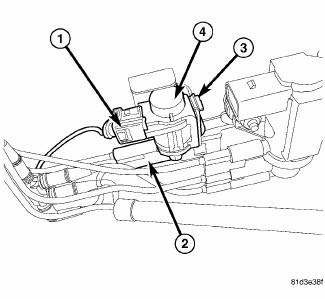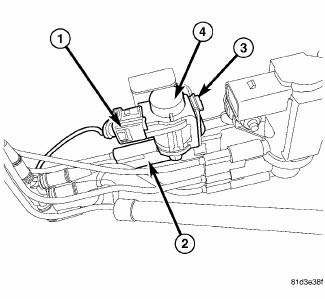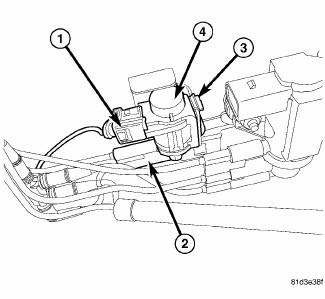Dodge Journey: Solenoid, exhaust gas recirculation (EGR), 2.0L Diesel
Description

Fig. 71: Exhaust Gas Recirculation (EGR) Solenoid - 2.0L Diesel
- - EGR solenoid electrical connector
- - EGR vacuum harness
The EGR solenoid (4) is mounted to a bracket attached to the battery tray in the engine compartment. The EGR solenoid serves two different functions. One is to control vacuum bleed-off of the EGR valve. The other is to control the "on time" of the EGR valve.
Removal
1. Disconnect negative battery cable.

Fig. 72: Exhaust Gas Recirculation (EGR) Solenoid - 2.0L Diesel
- - EGR solenoid electrical connector
- - EGR vacuum harness
2. Disconnect the EGR solenoid electrical connector (1).
3. Disconnect the EGR vacuum harness (2) from the EGR solenoid (4) valve block.
4. Release EGR solenoid retainer clip (3) and push down to remove the EGR solenoid valve (4) from the bracket.
Installation

Fig. 73: Exhaust Gas Recirculation (EGR) Solenoid - 2.0L Diesel
- - EGR solenoid valve electrical connector
- - EGR vacuum harness
1. Position and install EGR solenoid valve (4) onto bracket.
2. Connect EGR vacuum harness (2) to the EGR solenoid valve (4).
3. Connect EGR solenoid valve electrical connector (1).
4. Connect negative battery cable.
 Description, Operation
Description, Operation
DESCRIPTION
The EGR system reduces oxides of nitrogen (NOx) in the engine exhaust. This
is accomplished by allowing a
predetermined amount of hot exhaust gas to recirculate and dilute the incoming ...
 Valve, exhaust gas recirculation (EGR), 2.0L Diesel
Valve, exhaust gas recirculation (EGR), 2.0L Diesel
Description
The EGR valve is mounted to the intake manifold.
Operation
The engines use Exhaust Gas Recirculation (EGR) systems. The EGR system
reduces oxides of nitrogen (NOx)
in engine exhaust ...
See also:
Diagnosis and Testing
A/C EXPANSION VALVE
WARNING: Refer to the applicable warnings and cautions for this
system before
performing the following operation. Failure to follow the warnings and
cautions may ...
Installation
NOTE: Before stabilizer bar installation, inspect the cushions and
links for excessive
wear, cracks, damage and distortion. Replace any pieces failing inspection.
NOTE: Before installing the ...
Removal
NOTE: Before proceeding, review all Warnings and Cautions.
1. Raise and support the vehicle.
Fig. 39: TIRE AND WHEEL MOUNTING
2. Remove the wheel mounting nuts (3), then the tire and wheel a ...
